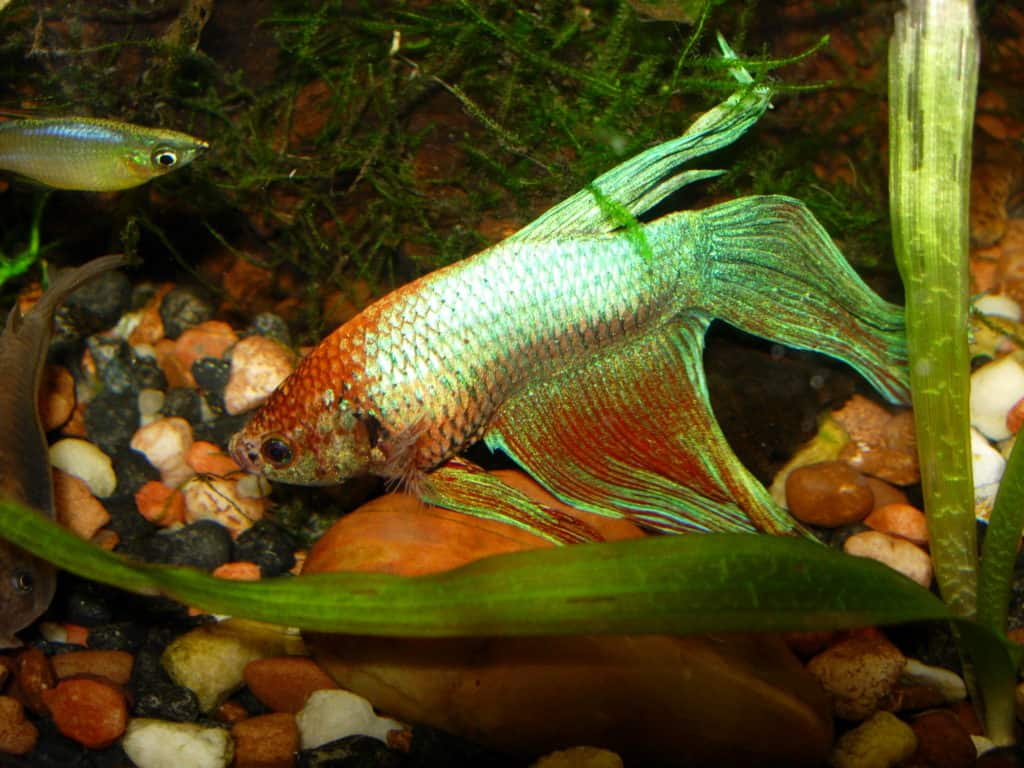**Post contains affiliate links.**
If you are concerned about a your betta fish laying on bottom of tank, here is a quick checklist of items to figure out what is wrong and how to fix it!
Quick Overview: Betta Swim Bladder Function
Like many other fish, bettas maintain neutral buoyancy through a specialized organ known as a swim bladder. This is a small sac of air contained within their bodies that runs just underneath their spinal cord. This is distinctively separate from their labyrinth organ, another specialized organ that is used to remove oxygen from the air instead of the water.
Bettas are assumed physoclistous fishes, where there swim bladder is not connected to their esophagus, but fills using a rete system that pulls gas out of the fish’s bloodstream. This is the exact opposite from koi and goldfish that are physostomous fish with an pneumatic duct between their esophagus and swim bladder, allowing them to inflate their swim bladder by swallowing air. Both types of fish use a specialized oval organ to remove excess air from the swim bladder. Malfunction of either of these mechanisms can cause buoyancy disorders in bettas. Negative buoyancy disorders in bettas are rare and lethargy is often secondary to illness, causing the fish to simply rest on the bottom of their tank.
Normal Betta Fish Behavior
Bettas are inherently lazy fish. It takes a lot of energy to drag around an ornate tail, so bettas will spend lots of time resting. Try to provide your betta with multiple places to rest comfortably, either a flat surface décor item or a betta leaf hammock. If your betta is resting on the bottom of a relatively sparse tank, it is not cause for alarm. Adding some appropriate décor items will often instantly inspire your betta to get off the bottom of his or her tank.
During feeding time, your betta should be quick to the surface and eat up all their pellets without too much difficulty. Remember, it’s hard to swim in a ballgown so don’t expect them to move as fast as other fish. Fish that are truly not feeling well will often not eat or be tempted to the surface for feeding time. This is an easy way for most betta owners to know if their fish is sick or not.
What to do for betta fish laying on bottom of tank
If your betta is in distress and lethargic at the bottom of their tank, your first step is to check your water quality. Just because your betta has their specialized labyrinth organ does NOT mean that you can forgo your regular maintenance! If your betta is kept in an antiquated bowl, or even worse, a vase, get them into a heated, filtered tank ASAP. Be sure to test your water quality with a liquid-based test kit that has been stored inside and opened within the last year. Here are the reference ranges for all water quality parameters for tropical fish, bettas included.
If your fish’s water chemistry is within range, the next step is to check their food. You should have opened their food container within the last 6 months and fed enough pellets two to three times a day that could theoretically fit within their eyeball. Here is more information on proper betta feeding.
If your water quality is within range and you have been feeding appropriately, the next step to help a betta fish laying on bottom of tank is to contact your aquatic veterinarian. Do not let health issues linger for very long. The sooner you get your fish some help, the better chance of full recovery.

